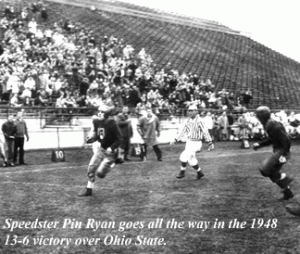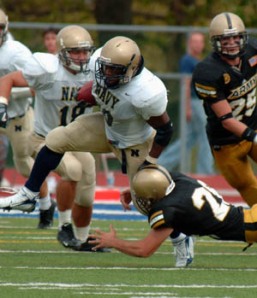Sprint Football: The Greatest Loophole in Sports
(Continued from Page 1)
The surprise isn’t just limited to players at a first-year program like Post, however. Longtime Cornell head coach Terry Cullen says most of his players had never heard of sprint football before they set foot on campus. “We have about 20 to 24 freshmen [every year] who don’t know about it, and they come out for the team,” he said. “We have 6 to 10 seniors who come out every year who don’t know about it.” Imagine playing a sport that is so invisible on campus that your own classmates go three full years without knowing you exist. Cullen says that there are “50 to 60 kids” who contact him as high school seniors, inquiring about the sport. “Most of them see it on our team website, or the league website,” he said. Still, Cullen estimates that only about one-third of his incoming players each year have heard about the sport before enrolling at Cornell.
Despite sprint football’s relative anonymity, recruiting has not proven to be too great a challenge for the league’s coaches.
Budget concerns have led to a CSFL rule that prohibits off-campus recruiting, so coaches must search for athletes either on their own campuses or over-the-phone. Still, there was enough interest that every league member besides first-year Post cut players from tryouts in 2010. Cullen, who has been the head coach at Cornell since 1978, said that the majority of his players were all-state athletes in high school, and that he gets about 85 to 90 kids who try out for the team each year. The maximum roster size in the CSFL is 65, so Cullen ends up with solid players on both sides of the ball. “Most of my linemen wrestled in high school, and the skill players are often all-state in football. A lot of them were all-state in lacrosse… so we get a lot of good athletes.”

Sprint football has survived with little fanfare since 1934. Here, Michigan scores the game-winning touchdown in a near-empty Ohio Stadium. (Photo courtesy: University of Michigan)
Cullen said that when he first started coaching, he was shocked at the level of play he saw. “I was pretty surprised at how good it was,” he said with a chuckle. “I kind of thought it would be like high school, a bunch of small guys who had never played before, but it’s not. It’s really good football. Everybody that’s playing loves football, and that’s why it’s so good.”
Mansfield University (Pa.) joined the CSFL in 2008 after dropping its Division II football team, or as head coach Dan Davis calls them, “the fat boy team” in 2006. Davis said that three-quarters of his players participated in high school football, and that many of them were all-state or all-conference selections. “This is high-quality football,” Davis said. “We’ve got a couple of ballplayers still left from the Division II team, and we do have some who have never [played football before]. But when you go out there and get hit for the first time on a football field, you figure out pretty quickly whether or not it’s for you.”
High school coaches agree that collegiate sprint football offers a high level of competition. Despite the fact that most coaches are primarily concerned with matriculating their star players into heavyweight college football, the ones that have heard of sprint football recognize the unique opportunity it offers their less physically gifted players. Incredibly, many high school coaches were surprised to learn that the sport exists when interviewed for this piece. Three separate Connecticut high school coaches, who declined to be quoted in this story, admitted they had never heard of the sport.
“I think the reason why many coaches don’t know it’s out there is because there aren’t many schools that offer it, so there aren’t many opportunities for kids,” said Post head coach Pete Ewald. “I think there will be more exposure for it in the next few years because of the fact that we joined the league, and Mansfield just came in a year ago. I think it’ll get more exposure regionally,” he said.
“I think sprint football is an excellent opportunity,” said James Wenker, who coached at various high schools in Connecticut and at East Stroudsburg State University in Pennsylvania for 10 years from 1986 to 1996. “As a high school coach, [sprint football] means more opportunities for my players to pursue their passion beyond my program. For the vast majority of athletes, it is the opportunity to participate that matters. Sprint football isn’t about the level of competition so much as it is about the fact that there are over a million athletes playing high school football and only 1,600 of them end up in the NFL. This gives the average guy a chance to compete at a high level without having their physical stature be a limiting factor.”
Despite its perceived high level of competition, sprint football doesn’t exactly draw huge crowds the way “fat boy” er—ahem, non-weight restricted football does. There’s no Friday night fever at Cornell, as about 55 fans showed up for the Big Red’s October matchup with Post last season. A few more lined the stands at Princeton’s Powers Field later that month to watch Post defeat the Tigers, 33-18, for the first win in school history. (Princeton, remarkably, has not won a game since 1999, a streak of 74 losses in a row.) Post saw over 1,000 fans attend the school’s first-ever home game at Municipal Stadium in Waterbury on October 30, 2010, but attendance is expected to dip once the team is no longer seen as a novelty.
Sprint football has survived at such a level of anonymity that even the heavyweight football coaches at schools that sponsor the sport admit they don’t see much of it. Navy’s Ken Niumatalolo, Cornell’s Kent Austin, Pennsylvania’s Al Bagnoli and Princeton’s Bob Surace all declined to be interviewed for this story because none of them felt comfortable talking about a sport that they don’t pay much attention to. “[Sprint football] games are usually played on Fridays, and the [heavyweight] team is usually on the road or preparing for the next game,” said Karen Berkley, an administrative assistant at Cornell. “The coaches really don’t get to see much of it.”
Despite general apathy from heavyweight coaches, students and fans, there is one annual showcase which attracts big-time attention from true sprint football fans. The Allegiance Bowl, or the annual showcase between Army and Navy, has filled stadiums at various neutral sites for nearly 30 years. Over 3,800 fans showed up to Rip Miller Field in Annapolis, Md., to watch Army defeat Navy, 32-30 in 2010. The 2011 game will be played in Saratoga, N.Y., which is about two hours from Army’s West Point, N.Y. headquarters.
In 1994, Sports Illustrated’s Brad Herzog wrote an article chronicling sprint football’s popularity in Pottsville, Pa., where two teams (one of which usually being Army), participated in an event known as the “Anthracite Bowl” on an annual basis from 1983 until 2001. The event became an opportunity for Pottsville residents to open up their homes to the athletes, hosting them for the weekend. Then-Army linebacker James Lewis was quoted in the article as saying that players would usually stay with the same hosts two or three years in a row, and then stay in contact with them through letters or visits. “For most of the guys on the team, it’s like a second family,” Lewis said.

Army and Navy dominate the CSFL. The two have combined to win 66 league championships. (Photo courtesy: Baltimore Examiner)
Pottsville residents loved having the athletes stay at their homes each fall because, as Herzog wrote, “The Anthracite Bowl provides a chance to help [Pottsville] children recognize their own potential by introducing them to dozens of likely role models—dedicated athletes from prestigious schools.” He noted that the 1993 event began on Friday with “a trip by both teams to the Good Samaritan Regional Medical Center to visit sick children and to judge a hospital-wide decorating contest, followed by a kickoff luncheon and a short ride to the local elementary school. There, the athletes signed autographs, answered questions, and lectured students about the dangers of drugs and alcohol. They also participated in a pep rally featuring, among other things, a rendition of Anchors Aweigh by a fourth-grade Flutophone band.”
For a sport that lives in virtual obscurity, that kind of treatment was a welcome nod of recognition for the athletes at the service academies. Army and Navy squared off in the Anthracite Bowl nine times during the eighteen-year span in which the game was held, including six times with the league championship on the line. In fact, Army and Navy have won a combined 44 outright titles and either academy has won at least a share of the championship 66 times since the league formed in 1934. “The league is dominated by those two,” said Cornell coach Terry Cullen. “When you look at it, just about everybody that goes to Army or Navy has played football, and they have a bigger pool to choose from,” he said. “One year I heard that Army had 300 kids try out.”
There’s no question that sprint football is a tradition at the academies, where former president Jimmy Carter once played during his time as a Navy midshipman. With the festivities that surround Anthracite Bowl, the Allegiance Bowl, and a trophy case that would make the New York Yankees blush, it’s no wonder that the service academies are seen as the standard in sprint football.
“When you look at the tradition that they have in this sport, it’s astounding,” said Post head coach Pete Ewald. “That’s what we’re trying to build here. It’s that love for the game, that passion that everyone at Navy and everyone at Army has for it, and the traditions they have… it’s easy to see that that’s what makes them successful.”
It may be even easier to see what makes the sport successful after 77 years of competition. Sure, it helps that the game is played at prestigious institutions which can afford to finance Friday night football games between student-athletes who can’t quite play with the big boys. (Cornell sprint football is financed 100-percent by alumni.) And sure, it doesn’t hurt that schools like Post will receive tuition money from athletes who otherwise would have never stepped foot on campus. Still, the thing that makes sprint football successful to this day is the same thing that made it successful back in 1934. The chance to stand in the tunnel and stare at the greenest grass—or Astro Turf, you’ve ever seen. It’s the kind of thing dreams—however small, are made of.
______________________________________________________________________________
William “Kels” Dayton is one of the up-and-coming writers in America. Check out his website, www.roundballdaily.com for more exclusive content.